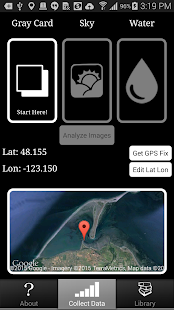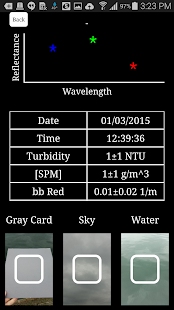Jeden Tag bieten wir KOSTENLOSE Android Apps und Spiele an die ihr sonst kaufen müsstet.
Android Giveaway of the Day - HydroColor: Water Quality App
This giveaway offer has been expired. HydroColor: Water Quality App is now available on the regular basis.
HydroColor is a water quality application that uses the a smartphone's digital camera to determine the reflectance of natural water bodies. Using this information, HydroColor can estimate water turbidity (0-80 NTU), concentration of suspended particulate matter (SPM) (g/m^3) and the backscattering coefficient in the red (1/m). IMPORTANT: HydroColor requires the use of an 18% photographers gray card as a reference. Gray cards are widely available at photography shops and online. Visit the supporting website for more information on gray cards.
HydroColor has an easy to use interface that guides users through the collection of three images: a gray card image, a sky image, and a water image. To ensure the best results, HydroColor taps into the device's GPS, gyroscope, and compass to aid users in the collection of these images. After images are collected they can be analyzed immediately. In the analysis of the images, HydroColor calculates the reflectance of the water body in the RGB color channels of the camera. It then uses the reflectance values to determine the turbidity of the water in NTU (nephelometric turbidity units).
The data is instantly saved and can be accessed again via HydroColor or downloaded onto a computer from HydroColor's data folder. The text file contains additional information about the measurement including: latitude, longitude, date, time, sun zenith, sun azimuth, phone heading, phone pitch, exposure values, RGB reflectance, and turbidity. Proceeds from HydroColor will go toward developing additional algorithms for HydroColor and to creating additional Apps like HydroColor.
How it works:
HydroColor uses the camera as simple light sensor (photometer). Relative light intensity can be measured by normalizing the camera pixel values by the exposure. Therefore, the three color channels of the camera (RGB: Red, Green, Blue) provide a measure of light intensity in three regions of the visible spectrum.
The light intensity measured in the water image is corrected for sky reflection off the surface (using the sky image). The corrected water image provides the intensity and color of light emanating from the water. This is normalized by the ambient illumination using the gray card image. The final product is a nearly illumination independent measure of the water’s reflectance, known as remote sensing reflectance. In oceanography, satellites are used to calculate the same product (remote sensing reflectance) from space.
The reflectance is directly related to the amount and type of suspended particles in the water. An increase in turbidly (i.e. suspended sediments) will cause greater scattering of light and increase the overall reflectance of the water. Particles containing pigments, such as phytoplankton (algae), will absorb light in specific regions of the visible spectrum. Thus, pigment containing particles can be detected by comparing the relative reflectance in the RGB channels.
Entwickler:
Thomas Leeuw
Kategorie:
Tools
Version:
1.9
Größe:
1.8M
Bewertet:
Everyone
Kompatibilität:
6.0 and up




Kommentare zum HydroColor: Water Quality App
Please add a comment explaining the reason behind your vote.